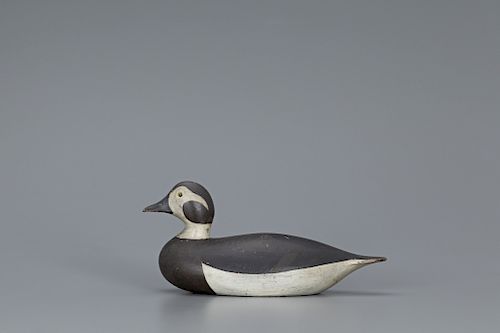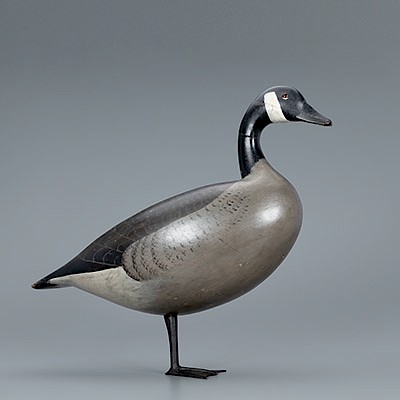The Spear Family Long-Tailed Hen, Joseph W. Lincoln (1859-1938)
Lot 197
About Seller
Copley Fine Art Auctions
20 Winter Street
Pembroke, MA 02359
United States
Founded in 2005, Copley Fine Art Auctions is a boutique auction house specializing in antique decoys and American, sporting, and wildlife paintings. Over the course of the last two decades, the firm has set auction records for not only individual decoy makers, but also entire carving regions. Copley...Read more
Estimate:
$40,000 - $60,000
Absentee vs Live bid
Two ways to bid:
- Leave a max absentee bid and the platform will bid on your behalf up to your maximum bid during the live auction.
- Bid live during the auction and your bids will be submitted real-time to the auctioneer.
Bid Increments
| Price | Bid Increment |
|---|---|
| $0 | $50 |
| $1,000 | $100 |
| $2,500 | $250 |
| $5,000 | $500 |
| $10,000 | $1,000 |
| $25,000 | $2,500 |
| $50,000 | $5,000 |
About Auction
By Copley Fine Art Auctions
Feb 16, 2019
Set Reminder
2019-02-16 10:00:00
2019-02-16 10:00:00
America/New_York
Bidsquare
Bidsquare : The Winter Sale 2019
https://www.bidsquare.com/auctions/copley/the-winter-sale-2019-3820
The sale will offer the opportunity to view and take home world-class paintings and fine bird carvings. Featuring selections from the collections of Alfred Ely, L. H. LaMonte, Grant Nelson, Ronald S. Swanson, Herb Wetanson, and a descendant of Chester F. Spear among others. Copley Fine Art Auctions cinnie@copleyart.com
The sale will offer the opportunity to view and take home world-class paintings and fine bird carvings. Featuring selections from the collections of Alfred Ely, L. H. LaMonte, Grant Nelson, Ronald S. Swanson, Herb Wetanson, and a descendant of Chester F. Spear among others. Copley Fine Art Auctions cinnie@copleyart.com
- Lot Description
The Spear Family Long-Tailed Hen
Joseph W. Lincoln (1859-1938)
Accord, MA, c. 1910
14 in. long
"Lincoln was a laconic man, a consummate Yankee craftsman whose solid-bodied decoys are reflections of their maker's personality—direct and spare, with not a gesture wasted. Their clean, crisp lines and reductively abstract paint patterns capture the essentials of each species' form and plumage with remarkable integrity and economy of means." - Robert Shaw, "Bird Decoys of North America"
The clean form of Lincoln's long-tail duck patterns combined with his exacting and elegant paint application make them one of his most desirable species. Very few Lincoln decoys of this species in original paint have ever surfaced. Highly coveted by acquisitors today, they are tucked away in some of the country’s premier decoy collections.
Many artists and makers depend on patronage and special relationships. As John C. Phillips was to A. Elmer Crowell and The Bishops Head Gun Club was to the Ward brothers, so the Spear family was to Joseph W. Lincoln. As hunting companions and reliable buyers of his decoys, Lincoln made some of his finest work for the Spears. Chester F. Spear (1888-1956), along with his younger brother, Ernie (b. 1897), and their father, Henry E. Spear (b. 1869), hunted the coastline just south of Boston, where they shot over their Lincoln rigs.
Dr. George Ross Starr came to know the Spear family and their exceptional decoys, eventually obtaining some, but not all of them. The most celebrated decoy in Starr’s collection was one that Chester Spear had reserved for the mantle. Starr recounts in his book that, “Many years ago Joe made the beautiful wood duck... for his friend Chester Spear of Scituate Harbor. It is an actual working decoy, but Chet liked it so much that it never left his mantle shelf. After Chet’s death, Mrs. Spear sold it to me for the collection. This is Lincoln at his very best.” The Spear Starr wood duck became the icon of the Starr Collection, even before it set the world record for a decoy at auction in 1986. Another one of Lincoln’s very best is this hen, which Spear also reserved from hunting. It descended through the family and Spear’s daughter kept it on her mantle despite Starr’s attempts to acquire it.
Having remained in the same family for three generations, it is ranked, along with the O’Brien cover lot example, as the best of its kind. Consigned directly from the Spear family, we are honored to offer this unrigged Lincoln decoy for the first time since it was made over a century ago. Excellent original paint with minimal wear, a chip to bottom of original bill is reset.
Provenance: Chester F. Spear Rig, acquired from the maker
By descent in the Spear Family
Literature: George Ross Starr, Jr., M.D., "Decoys of the Atlantic Flyway," Tulsa, OK, 1974, p. 155, fig. 75, rigmate illustrated.
Cap Vinal, "Joseph W. Lincoln," Rockland, MA, 2002, p. 44, related examples illustrated.
David S. Webster and William Kehoe, "Decoys at Shelburne Museum," Shelburne, VT, 1961, p. 68, related decoys illustrated.
Laurence Sheehan, "The Sporting Life," New York, NY, 1992, p. 82, related decoys illustrated.
Copley Fine Art Auctions, “The Donal C O’Brien, Jr. Collection of Important American Sporting Art and Decoys, Session III,” Hingham, MA, July 19, 2018, front cover and lot 39, related example illustrated.
Robert Shaw, "Bird Decoys of North America," New York, NY, 2010, pp. 138-139 and 156, related example illustrated.Condition report requests can be made via email or by telephone (info@copleyart.com or 617.536.0030). Any condition statement given is a courtesy to customers, Copley will not be held responsible for any errors or omissions. The absence of a condition statement does not imply that the lot is in perfect condition.Condition
- Shipping Info
-
Shipping info
Copley Fine Art Auctions does not handle the shipping of any items. Shipping is the sole responsibility of the buyer. Once your payment has cleared, and we have received your authorized shipping release form items may be released for shipment. Copley Fine Art Auctions, LLC shall have no liability for any loss or damage to such items. Buyers should allow up to four weeks for shipment.Please be aware that internet bidders may NOT not pick up their items at the sale. Items will be available for pick up by appointment or by shippers five days after the sale.
-



 EUR
EUR CAD
CAD AUD
AUD GBP
GBP MXN
MXN HKD
HKD CNY
CNY MYR
MYR SEK
SEK SGD
SGD CHF
CHF THB
THB















